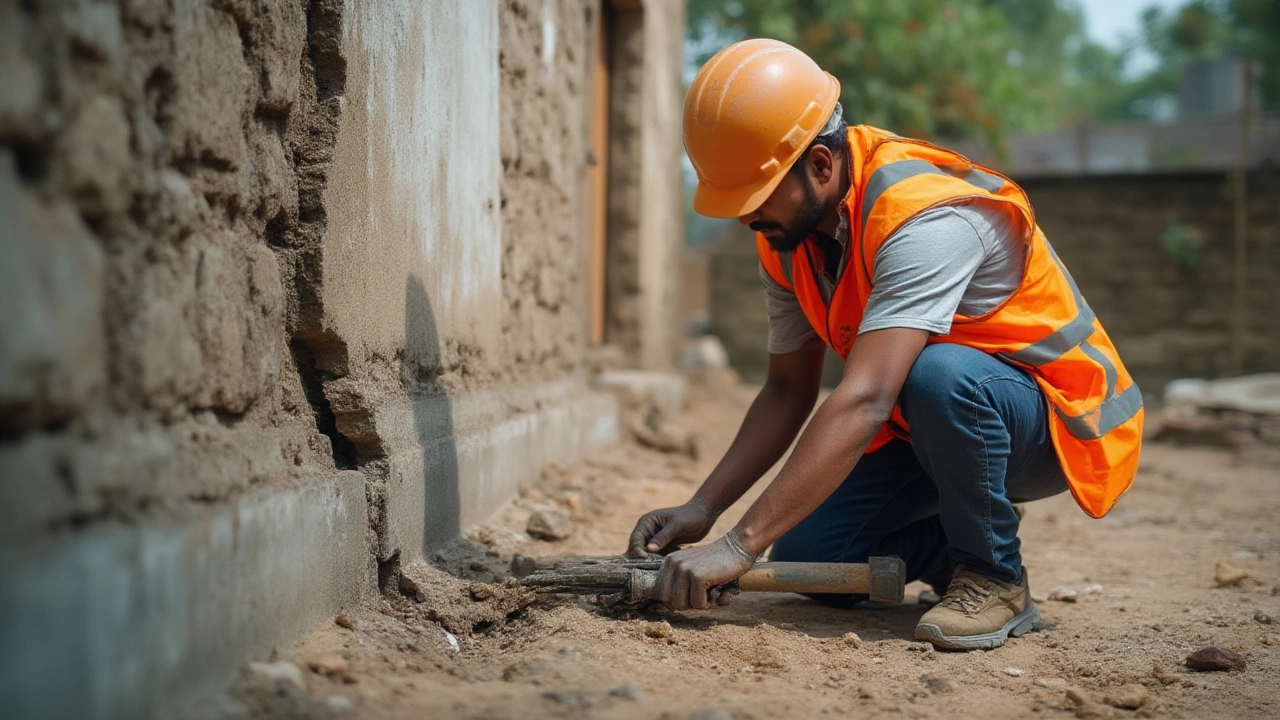Staring at a fresh crack running up your basement wall will send a chill down your spine faster than Rocky hearing thunder. Foundation cracks look terrifying and sometimes, yeah, they are a signal to worry. But not every crack means the end is nigh for your house—and some you can absolutely tackle yourself. Knowing the difference between a cosmetic nuisance and a structural crisis can save your wallet and your sanity. So, can you fix a foundation crack yourself? You bet—sometimes. But don’t grab the caulk gun just yet. First, let’s get wise about the real risks and limits of DIY foundation repair.
Understanding Foundation Cracks: When Is DIY Okay?
You see a crack in the concrete, and the instinct is to panic or call a contractor. But the truth is, foundation cracks are pretty common, especially in homes built on shifting soil or that have seen a lot of rain and freeze cycles. There are three main types: hairline cracks, wider but stable cracks, and gaping, shifting fissures that spell real trouble. To figure out if you’re in the DIY camp, you need to get up close and personal with that crack.
First off, hairline cracks—those are less than 1/8 inch wide and not growing—are almost always a cosmetic issue. These guys show up thanks to normal settling or changes in temperature and moisture. Sometimes you’ll see them in new concrete, sometimes in older houses after a wild rain season. Wider cracks, anything between 1/8 inch and 1/4 inch, need a little more attention: if they’re not growing or shifting, fixing those yourself is usually safe.
Cracks wider than 1/4 inch, uneven (meaning the two sides of the crack are different heights), or running at a sharp angle—in those cases, DIY isn’t just risky; it’s a flat-out bad idea. These cracks can mean foundation settlement or structural shifts. Here’s a quick way to check: stick a clear ruler or a quarter into the crack, mark the ends with a pencil, then check back in a month. Any growth or shifting? That’s your cue to call an expert, not smear on more epoxy.
Some cracks also let in water—and if you walk into your basement after a rainstorm to find puddles, that’s a sign of what builders call a “dynamic” crack, one that’s potentially letting in groundwater. Repairing from the inside can help, but if the water just keeps coming back, you might be dealing with drainage problems or even hydrostatic pressure. A study by the American Society of Civil Engineers found 25% of US homes experience some kind of structural distress—so you’re not alone. Just be honest with yourself: if you see bowing walls, lots of cracks popping up at once, or doors/windows sticking, professionals should step in.

What You’ll Need Before Rolling Up Your Sleeves
So your crack has passed the DIY sniff-test—nice. Before you buy anything, clean up the area and check for stains, loose debris, or mold. Mold or efflorescence (that chalky white stuff) means moisture, and you want a dry surface for any patch to work. If you don’t dry things out, you’re just trapping problems inside. A dehumidifier and a shop vac become your friends here. Rocky once tried to help by nudging the vacuum hose, but leave the pets out of this step.
Here’s a breakdown of what you’ll need:
- Wire brush for cleaning
- Shop vac or brush for dust
- Concrete crack filler or epoxy injection kit (look for ones specifically marketed for foundation repair)
- Putty knife or trowel
- Protective gloves and goggles
- Spray bottle with water (helps some fillers bond better)
- Painter’s tape or masking tape
Now, plenty of fixes fill store aisles: quick-set cement, polyurethane foam, hydraulic cement, injection epoxies. For cracks that don’t leak, a basic concrete filler often does the job. For cracks with occasional leaks, polyurethane foams expand and seal water out. Epoxy injections, while pricier, actually glue the concrete back together and restore some structural strength—these work best on dry, non-flexing cracks. The most important thing? Always read the labels. Some products are made for hairline cracks, others need wider openings. If you ignore those directions, you’re wasting money.
Even the pros agree: prepping the surface is half the battle. You can’t patch over loose concrete or dirt. Use a wire brush to scrub chewed-up edges, then vacuum everything out. For deep cracks, you might need a chisel to undercut the edges so the patching material has something to grip. The cleaner and rougher the crack, the better your patch will hold. Don’t rush this. One contractor told me he spends more time prepping than patching—good advice for amateurs too.
| Type of Crack | Typical Width | DIY Repair? | Recommended Materials |
|---|---|---|---|
| Hairline | < 1/8 inch | Yes | Concrete filler, flexible sealant |
| Stable Narrow Crack | 1/8–1/4 inch | Yes (if not growing) | Epoxy, polyurethane foam |
| Wide/Growing Crack | > 1/4 inch | No | Professional assessment needed |
| Uneven/Bowing Walls | Any | No | Professional repair |
Some people might want to skip gloves or safety goggles, but don’t. Concrete fillers can irritate skin, and you don’t want anything in your eyes. Rocky once sniffed a bit of cement dust and had a sneeze attack for hours—you don’t want that, trust me. And always let the area you’re repairing dry completely before moving on to the actual patch.

Step-by-Step: How to Repair a Foundation Crack Yourself
Ready for the fun part? Roll up those sleeves (but maybe not your good shirt). There’s an art to fixing a crack that lasts, and it’s not about brute force. Here’s a straightforward approach that works for most DIY-appropriate cracks.
- Clean the Crack Thoroughly: Use the wire brush and shop vac to remove all loose dust, crumbling concrete, or other debris. If the crack is damp, wait for it to dry. For cracks that run through to the outside, stuff a little backer rod or foam rope in the deepest part–that way, your patching material doesn't just ooze through.
- Apply Masking Tape: If you want a neat job, run tape along both sides of the crack. This prevents the filler from spreading onto clean concrete and leaving a mess you have to scrub off later.
- Mix and Apply the Patch: Follow directions exactly! For pre-mixed crack fillers, squeeze a bead into the crack, working it in with the putty knife. For 2-part epoxy kits, mix thoroughly and use the included applicator. Don't just smear it on top—press it deep into the crack so it bonds well. Some cracks need multiple passes, especially if the filler sinks as it cures.
- Finishing Touches: Use the putty knife to smooth the patch flush with the wall. If you're using epoxy or a similar high-strength product, you might need to sand it later once it's fully cured for a perfectly smooth look.
- Let It Cure: Respect the cure times listed on the packaging. Some fillers set in minutes, others take a few hours. Don’t rush this—disturbing or painting over a patch too early can ruin the bond.
- Check Your Work: Once everything's dry, remove the tape and inspect the patch for any gaps or shrinkage. For water-prone cracks, hose the outside wall or wait for the next big rain and make sure nothing gets through.
- Keep Watch Over Time: Mark the area, even jot down the date nearby. Check back every few months. If the crack grows or reopens, that’s your sign to call in the professionals.
One tip I’ve picked up: if your house keeps getting hairline cracks every year, it’s worth checking your gutters and grading outside. Bad drainage sends water toward your foundation, causing all sorts of trouble. Redirect downspouts at least 6 feet from the house and make sure the ground slopes away rather than toward your walls. According to National Home Builder stats, 80% of foundation issues start as drainage problems. You can spend thousands fixing cracks—or a hundred bucks on a new downspout. Guess which I’d rather do.
And yes, you can paint or seal over most repaired cracks after they’re cured. Just make sure you’re using basement- or masonry-safe coatings. If you smell mold or notice dampness even after repair, track down the water source before doing anything else. Ignoring that means you’ll just keep patching cracks forever.
The satisfaction of fixing something in your own house is tough to beat—you just feel a little taller, even if your dog is no help and just watches from the couch. But know your limits; not every crack is a DIY win. When in doubt, a quick consultation is way cheaper than a major foundation overhaul. And don’t be shy—better safe than sorry, because foundations really don’t forgive mistakes.

